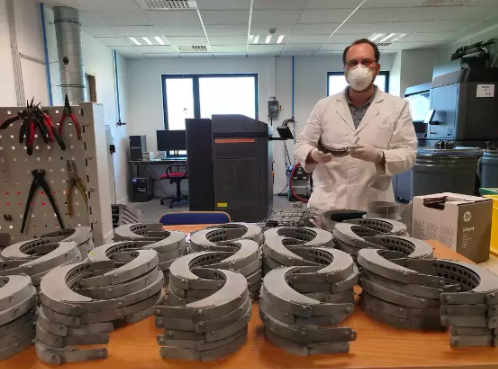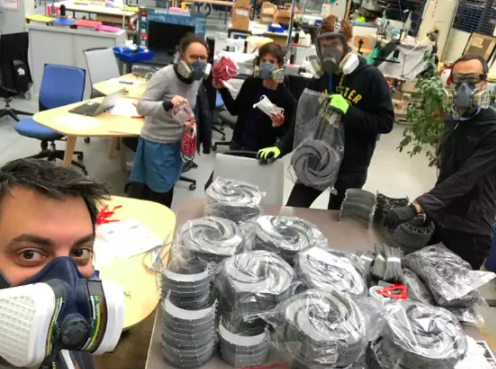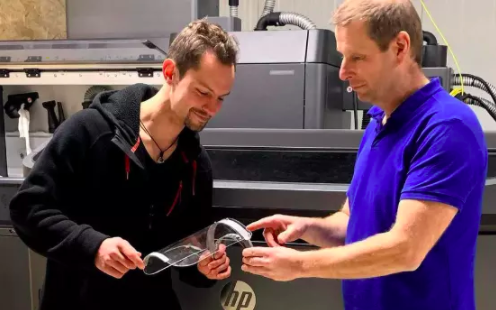From Crisis Comes a Shared Vision for Face Shields
August 6, 2020 /3BL Media/ - French hospitals struggled to find face shields for doctors and nurses—until local companies turned to 3D printing for a solution.
On a Saturday morning in mid-March shortly after French President Emmanuel Macron ordered a nationwide coronavirus lockdown, Alain Moinat was at home near Paris, surfing the web. As president of Paris-Saclay Hardware Accelerator (PSHA), a studio and consulting firm that helps startups design and build prototypes using 3D printing technology, Moinat had dutifully shut down his business. Now confined at home, he wondered if he could possibly get any work done.
He got his answer when he scrolled to a LinkedIn post by Alexandre Martel of 3Dnatives, a digital media platform dedicated to the advancement of 3D printing.
Martel had posted an urgent request from the public hospital in Caen, about 125 miles northwest of Paris, for clear plastic face shields to protect the eyes of doctors and nurses from the deadly virus. Moinat thought, “I can print those.” He downloaded the file for a Spanish 3D-printed face shield, then ventured into his studio.
After a little trial and error, Moinat decided that the Spanish design would take too long to print due to its complex design. So, he took matters into his own hands and designed his own face shield, following medical experts’ guidelines. By Monday, he had printed six usable prototypes on his single HP Multi Jet Fusion printer.
He got his answer when he scrolled to a LinkedIn post by Alexandre Martel of 3Dnatives, a digital media platform dedicated to the advancement of 3D printing.
Martel had posted an urgent request from the public hospital in Caen, about 125 miles northwest of Paris, for clear plastic face shields to protect the eyes of doctors and nurses from the deadly virus. Moinat thought, “I can print those.” He downloaded the file for a Spanish 3D-printed face shield, then ventured into his studio.
After a little trial and error, Moinat decided that the Spanish design would take too long to print due to its complex design. So, he took matters into his own hands and designed his own face shield, following medical experts’ guidelines. By Monday, he had printed six usable prototypes on his single HP Multi Jet Fusion printer.
An unprecedented collaboration
As soon as Moinat recognized the urgent need, he reached out to his partners at HP France for help. “They guaranteed us full assistance,” he says. HP agreed to provide the crucial PA-12 plastic powder for the shield’s brow piece, which can be sterilized, at cost. (The face shield itself is cut from sheets of clear plastic.) “The hospital told us they had received others made of an inferior plastic that could not be sterilized,” says Moinat.
Indeed, after the hospital performed rigorous tests on the PSHA face shields, they begged for more. “The materials used are perfectly suitable,” says Christophe Vildary, in charge of risk prevention at the hospital. “And the cold light helmet used by specialists fits perfectly over the face shields.”
After committing to supply the plastic powder for the face shields, HP helped publicize the project on French TV and radios, which in turn brought in more partners—everyone working at cost. Among the French companies now involved are cosmetics giant L’Oréal and Decathlon, the maker of athletic gear. The group effort also received ongoing organizational help from Martel at 3Dnatives.
Early on, Martel called Pierre Kraus, lab manager at Aereco Group, based in Collégien, east of Paris, which normally manufactures building ventilation systems. “When the lockdown began, I had already decided to design and print some hands-free door opening systems,” says Kraus. “Having seen the impact of 3D printing in the fight against disease in Italy, I had asked the company’s management in advance for approval to participate this way. They agreed immediately.”
When Martel told Kraus about Face Shields of Hope, Kraus swung into action.
"I immediately started to print parts even without waiting for the elastic headbands supplied by other companies, because 3D printing seemed to be the bottleneck in production,” Kraus said. “Other companies, most of whom we already knew, quickly joined. Decathlon lent me an additional build unit to double our production.”
Julien Guillen, leader of additive manufacturing at Decathlon, says his company went beyond 3D printing the brow pieces to also begin laser cutting the clear shields and creating a machine to automate the cutting of thousands of elastic bands per day.
“We also worked on other parts of the value chain participating in the quick creation of an IT tool, and the management and distribution of 3D-printed face shield components that have to move between the many partners using HP technology and logistic centers for shipment to hospitals,” Guillen says. “It was, in short, a small factory in itself.”
Meanwhile, new and improved versions of the face shields could be iterated quickly on the HP Multi Jet Fusion printers. The revisions made them safer, more comfortable and easier to print. At the same time, the participants set up daily virtual meetings to organize supplies and manage requests and shipments. “This approach allowed me to concentrate on manufacturing,” says Kraus. “I continued without stopping a single day for four weeks. It seemed obvious to me, since I had the capabilities, to help the medical staff on the front line as much as possible. We were even able to offer a set of face shields directly to the wife of a colleague who’s a nurse in a hospital.”
Likewise, Moinat and one associate at PSHA have worked day and night to make the face shields—unwilling to endanger more employees by calling them in for relief.
Moinat says he took inspiration from the hospital workers he met through the project. In early April, after delivering 100 face shields to Longjumeau Hospital south of Paris, Moinat wrote on LinkedIn: “The medical staff show no signs of fatigue or weariness on the job, they are there for patients and there is no room for complaints. Well done to all of you who save our lives.”
The gratitude is mutual. Vildary, from Caen’s public hospital, said on national radio, “When I distribute the face shields to the staff, everyone is happy. They feel appreciated in these difficult times.”
A “great solidarity”
Moinat acknowledges that keeping up with national demand—on a total of 15 HP Multi Jet Fusion printers—has been challenging. “The hospitals love them and want more,” he says. “The National Police called yesterday to have face shields made for them, and the postmen want them, too.”
Now, Face Shields of Hope is poised to ramp up conventional factory production of the shields and other protective gear, with an innovation pool based in Toulouse and overseen by the French Federation of Plastic. Participants in that group include industrial giants like Airbus and Renault, which plan to churn out hundreds of thousands of pieces for use across Europe—for hospitals and also factory workers, once they can safely return to their jobs.
But the original partners have not entirely passed the baton to big factories. For one thing, Moinat continues to print the prototype iterations that factories use to make molds. And he notes that 3D print operations “can quickly fill orders for local demand, such as small businesses.”
Adds Kraus at Aereco, “We will surely continue manufacturing other kinds of parts to support our hospitals. This operation revealed the great solidarity that could be created in the face of a crisis—both within our company and between companies, even competitors.”
Moinat, whose passion is developing autonomous industrial production in his country, offers another view of what is possible with creativity, ingenuity and local collaboration: “With Face Shields of Hope, we built a new industry in France in seven days.”
About HP
HP Inc. creates technology that makes life better for everyone, everywhere. Through our portfolio of personal systems, printers, and 3D printing solutions, we engineer experiences that amaze. More information about HP Inc. is available at www.hp.com/go/3DPrint.
Contact
Chad Mack
chad.mack@hp.com




